The design proposals for the Eye of York – the space between the Female Prison, the Debtors Prison (York Castle Museum) and the Court – have brought into focus a choice about the space and its specific character within the reshaped Castle Gateway. The current grass roundabout known as the Eye of York facilitates traffic movement but little else. Those coming into the area only rarely walk on or sit on the grass. There is an oak tree in the centre of the roundabout.
Throughout the public engagement we have been asking why does the Eye of York matter to us? What would we like to be able to do there? The Open Brief set out these different meanings and uses.
BDP, the designers, have produced proposals which enable greater activity in this space. But these designs prompt a question – will the tree help or prevent our hopes for this part of York?
In this presentation Andy Kerr, Castle Gateway project lead and Matthew Costa, Landscape Architect from BDP introduce design ideas for the new space.
Why does the Eye of York matter to us?
In the My Castle Gateway Open Brief the Eye of York is seen as having important symbolic uses based on its histories.
It is a place of authority – and of contesting authority.
It is a place that has been defined by its Castle and later Prisons and a Court. People were imprisoned there, transported and hanged.
It is also a place where authority has been contested in different ways. William Wilberforce was elected there on an anti-slavery ticket – and a place that drew protesters through the 19th century, not least The March Against Yorkshire Slavery in 1832. York was where those arrested after Peterloo were marched to be prosecuted. The Luddites were prosecuted and hanged there. Chartist leaders imprisoned there.
Graffiti by those imprisoned can be seen on the walls of the prison buildings – the personal colliding with systems and structures of political order.
The Eye of York matters as a place where what democracy might be and has become has been asserted and contested.
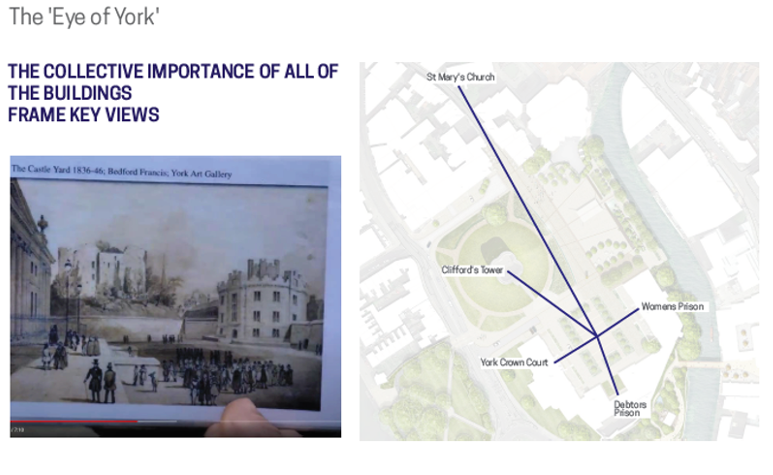
What do we want to be able to do there?
The Open Brief sets out that we still want to use the Eye of York as a place to gather, whether for the St George’s Day Parade or for protests.
We want to:
- Use it as a place for discussing and debating current issues, whether through a Speakers Corner or other forms of gathering.
- Acknowledge the authority contained in the buildings – they are meant to make us feel intimidated! – but to soften this, so we can take the space over and comfortably spend time there.
- Understand the personal stories behind the imposition of authority and to remember those that were transported or died there. This could be done through highlighting the graffiti and other personal stories and making it clear where the Last Drop is and dealing with this area in a sensitive way.
- Appreciate the views towards Clifford’s Tower, the court and the prison buildings and St Mary’s Church.
- Use the area at night. We want the area to be beautifully lit at night so it is a great place to hang out. There might be pop up vans selling food and drink, with the vans using the built in electrical infrastructure so there are no noisy generators.
- There was also an interest in the area feeling different from the other public spaces in the area, including the new space being created where Castle Car Park is currently.
- Across the whole Castle Gateway area there was also an interest in creating climate resilient public space with shade and shelter, which increases biodiversity, improves air quality, mitigates urban heat island effect (where having lots of buildings, roads and other and hard spaces together intensifies heat) and slows down the amount of rainwater heading down drains to contribute towards flood management.
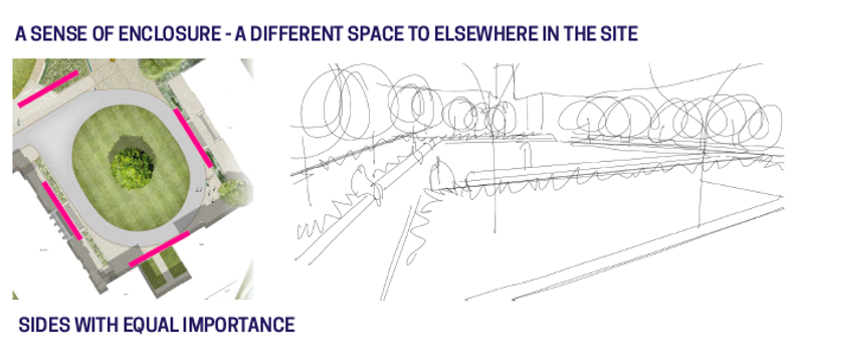
Proposals for an active civic space
York Museums Trust want the space to become much more practical and useable for events and for engagement activity. This fits with ambitions for the Castle Museum to become the national collection of everyday life as well as being better able to tell the story of the Castle and the stories of the buildings and the people associated with them.
York Museums Trust want the space to be as physically accessible as possible so that everyone can enjoy events and engagement activity in this area. Creating level access will be key to open up the possibilities for the kinds of events and activities the space will be able to accommodate. York Museums Trust also want to ensure that the access to and views of the important historic buildings are kept as clear and uninterrupted as possible.
Examples of events York Museums Trust would like to do there:
- Showing some of the larger and heavier objects that are in our stores and not easily displayed in our galleries because of room on gallery – we have a number of vehicle sized objects that we have wanted to promote, show for a day and return to stores.
- Physical, community events to connect our buildings and collections and engage the community with us through activity particularly in a post covid world where people will be more easily persuaded to attend and feel safer outdoors
- Public exhibitions where we always need good level access and high quality infrastructure to make them of sufficient quality that they achieve the outcomes we and our audiences want and also the right visitor experience such that visitors recommend to their friends and return again in the future for the next one
- Public performances with the buildings as a backdrop – dance/ theatre/ music / community staged. They all need level access and good infrastructure and we have been unable to secure any of this to date.
English Heritage are also interested in what the new designs for the Eye of York might make possible in terms of events and other activities.
The design proposals and the oak tree
The oak tree was planted – likely in 1981 – to mark the tenure of Alex Lyon as MP for York. Lyon was first elected in 1966, so it would appear to be a 15 year anniversary.*
The planting of the tree provoked some controversy at the time and was initially a very small sapling. It has grown over time to be a mature tree. It is this fact – that it is a mature oak tree – that means we need to look very carefully at any proposals to remove it.
Yet the tree does prevent certain kinds of activity.
The roundabout does not currently offer a sense of enclosure. While it does soften the authority of the buildings it doesn’t enhance key views. The tree prevents key views, in particular between the Court and the Female Prison steps.
The Eye of York currently is not a very easy place to spend time. The grass is not very nice to sit on and there are very few benches; sitting on the grass itself can be problematic as it attracts geese and the geese foul the area. The heavy shading of the tree further impedes the health of the grass beneath it. At the same time it doesn’t provide very usable shade for people to sit in when hot and sunny.
The roundabout will no longer be needed to create access to the Castle Museum or Court as this is being dealt with in other ways.
Options
The designers have developed four options, two with the oak tree removed and with new tree planting and two options to show what would be possible if the tree was kept.
The Council’s Castle Gateway’s Project Team have got a preferred option, Option 2.
Option 1: Enclosure, key views, smaller trees, benches, hard space for events
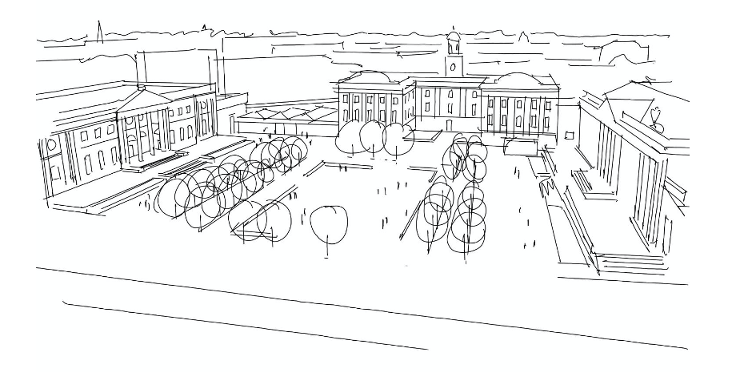
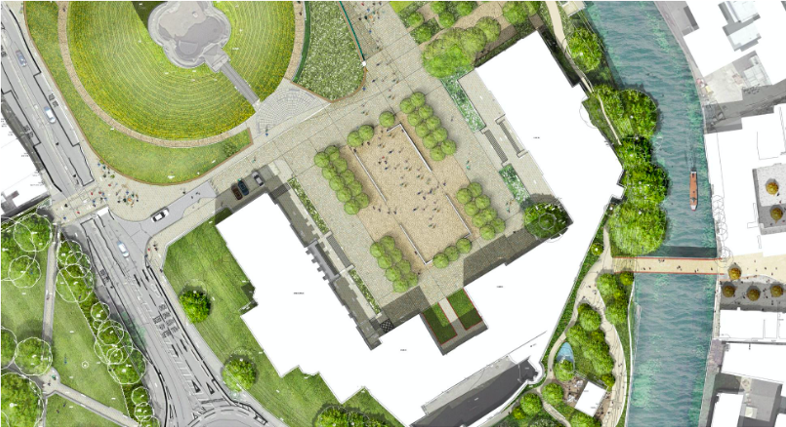
In this option the tree and the roundabout are removed creating a hard space that can be used for activities. Trees are carefully placed to allow for key views towards Clifford’s Tower, St Mary’s Church and between the Female Prison and the Court, enabling the sense of authority of the area to be appreciated. Benches and seating are provided in an enclosed square to give a sense of gathering – and a space to speak back to and contest that authority. The new trees would provide shade and cool in summer over a large area. The tree species would be carefully chosen so they would not get too big and come to dominate the area.
Key features against the Open Brief requirements:
- Creates a rectangular hard space for activities.
- Key views between the Court and the Female Prison and towards Clifford’s Tower and St Mary’s communicating the power and authority of crown, church, court and prison.
- An area with a central focus for gathering, echoing the history of the area as a site for hustings, elections and protests.
- 42 trees to provide shade in the summer and shelter in the winter.
- Bistro seating under the trees and benches around the edges.
- Allows for the dominance and intimidating presence of the Georgian buildings to be appreciated and softens it using trees to create human-scale space, reflecting the dynamic of power and personal stories in the area.
Option 2: Enclosure, key views, smaller trees, benches, hard space for events but also with softer planting and more grass
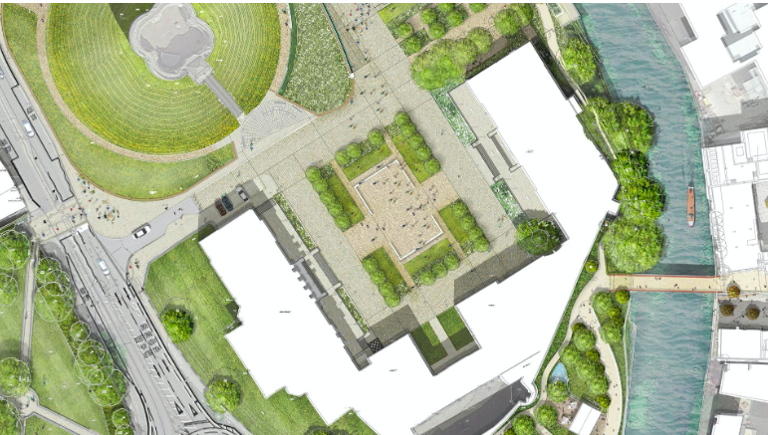
Option 2 is the preferred option of the Council’s Castle Gateway’s Project Team
Option 2 offers the same benefits as Option 2 but has grass and other planting. Grassed areas would give informal space for picnics or relaxing, and informal shrub planting would soften the feel of the space and encourage wildlife including birds and pollinators.
Key features against the Open Brief requirements:
- Creates a rectangular hard space for activities but with more hard space given over to grass and planting than in Option 1.
- Key views between the Court and the Female Prison and towards Clifford’s Tower and St Mary’s communicating the power and authority of crown, church, court and prison.
- An area with a central focus for gathering, echoing the history of the area as a site for hustings, elections and protests.
- Trees to provide shade in the summer and shelter in the winter.
- Greater biodiversity created through planting.
- Benches around the edge of the square.
- Places for sitting and picnicking on the grass (instead of the bistro style seating under the trees in Option 1).
- Allows for the dominance and intimidating presence of the Georgian buildings to be appreciated and softens it using trees and planting to create human-scale space, reflecting the dynamic of power and personal stories in the area.
Option 2: A smaller hard space for gathering and activities is created, enclosed by trees, planting and grass, highlighting key views, interpreting both the authority of the buildings and using trees to soften and create human scale space. Seating is via benches around the central space and on the grass.
Options 3 and 4: Enclosure, key views, keeping the oak tree, space for seating, adding new trees and planting.
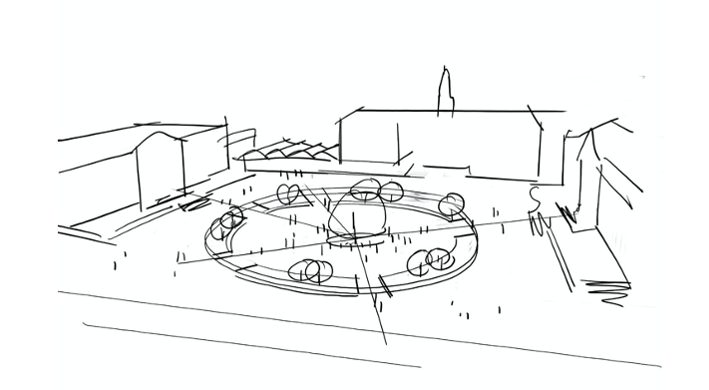
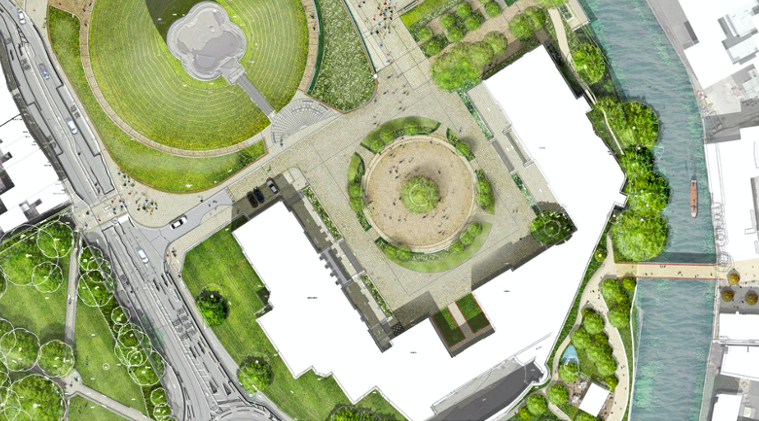
Options 3 and 4 explore a version of meeting the Open Brief while keeping the oak tree. Some of the Open Brief can be met this way including a sense of coming together and gathering, a place to spend time and reflect. These options would make events and other activities harder to hold here and the tree would continue to block key views between the Court and Female Prison and therefore conveys the heritage of the area less clearly.
The difference between Option 3 and 4 is whether the shape is oval or circular.
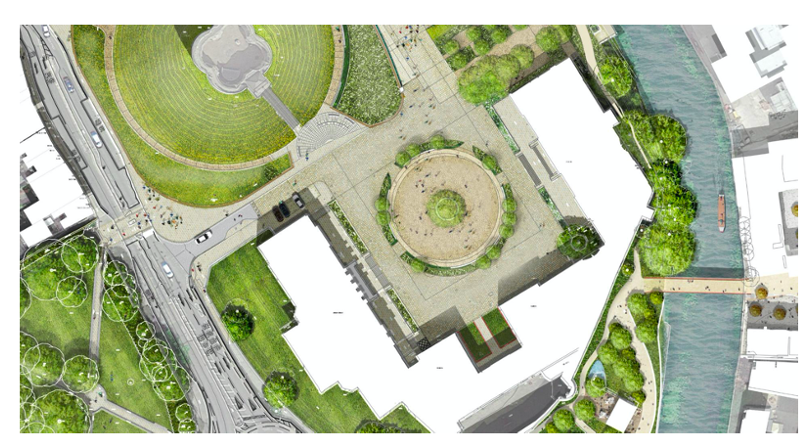
Key features against the Open Brief requirements:
- Some hard space created, could be used for small scale activities around the tree. Larger scale activities would not be possible.
- Certain views are enabled from certain places in the circle/oval, other views blocked by the tree.
- Benches around the edge of the circle/oval.
- In Option 3 places for sitting and picnicking on the grass (absent in Option 4).
- Allows for the dominance and intimidating presence of the Georgian buildings to be appreciated and softens using trees and planting to create humans-scale space, reflecting the dynamic of power and personal stories in the area.
How to get involved in the conversation?
Comment on this blog post
Comment via facebook – the City of York Council page, My Castle Gateway facebook group or page.
Comment via twitter
Emails us: [email protected]
* There are two published reports that mention the planting of the tree. Mentioning different timeframe that might have been being commemorated – 25 or 10. The most accurate evidence is probably that in 1981 there was a ’pit for planting the tree’ documented by the York Archaeological Trust watching brief (Eye of York watching brief (YORKYM: 1981.1033/ YAT Gazetteer site no. 244). Given Alex Lyon was elected in 1981 this would make it a 15 years commemoration.
Some interesting proposals. But what sort of ‘activities’ would be compatible with the use of the existing courts for legal proceedings. Where some dignity and quietness is important to the proper discharge of justice. I would prefer more thought to be given to the use of the square for outside display of larger museum exhibits -to bring the museum collection to the people to induce greater demand.
Thanks Roger, I’ll pass one the point about museum collections to the York Castle Museum, I know they are interested in how to bring the musuem outside. The council team have been in close discussions with the Court – it is clear that Monday-Friday during court sitting hours activities in the Eye of York area will need to be quiet and respectful but that there is scope for other kinds of activities outside those times.
From what I understand from other Posts, that who ever has picked a 2 bite apple sort on design and that “Residents/Companies picked it